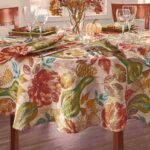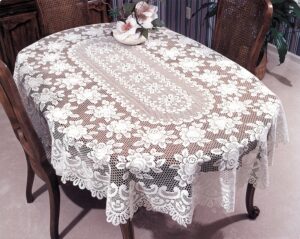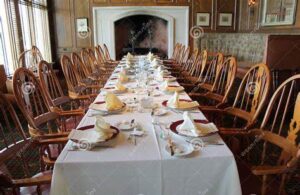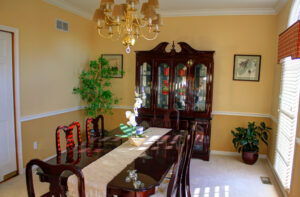
 Tablecloths…usually used to dress up a table, often for a holiday dinner these days, were not always used for that purpose. Children wiping their mouths on tablecloths isn’t generally acceptable at the dinner table these days, but that was their original use! It was like a community napkin. Guests were meant to wipe off their hands and face on a tablecloth after a messy feast, and not do this would be considered bad table manners! These days it’s pretty much the opposite. The idea is to try not to “spill” or otherwise mess up the tablecloth.
Tablecloths…usually used to dress up a table, often for a holiday dinner these days, were not always used for that purpose. Children wiping their mouths on tablecloths isn’t generally acceptable at the dinner table these days, but that was their original use! It was like a community napkin. Guests were meant to wipe off their hands and face on a tablecloth after a messy feast, and not do this would be considered bad table manners! These days it’s pretty much the opposite. The idea is to try not to “spill” or otherwise mess up the tablecloth.
While original tablecloths were usually white…another odd idea, considering the practice of wiping one’s mouth and hands with the cloth, today’s version is often colorful, and decorative to match the holiday currently being celebrated. The most common shapes for tablecloths are round, square, oval, and oblong, or rectangular, corresponding to the most common table shapes. Tablecloths usually have an overhang, referred to as the “drop” of about 6 to 15 inches on each side of the table. The shorter drop is usually for casual dining and a longer drop for more formal occasions. Sometimes a floor-length cloth is used. Custom-made tablecloths are also available, and some people choose to make their own.
Some tablecloths are just decorative, and often used on a wooden table to help protect the table from scratches and stains. Others are designed to be spread on a dining table before laying out tableware and food. In formal settings, tablecloths are designed as part of an overall table setting, with coordinating napkins, placemats, or other decorative pieces, and in very formal settings the might also be “runners” overhanging the table at two ends only and “table protectors” which provide a padded layer under a normal tablecloth.
Today’s more casual, and less expensive tablecloths are typically made of cotton, and some have a poly-cotton blend, or a PVC-coated material that can be wiped clean. Of course, any material works, and some people use delicate fabrics like embroidered silk. Today, the biggest consideration, at least in casual settings, is ease of cleanup, so the material might be chosen for its ability to fight stains.
Of course, one more use for a tablecloth, was in shows, where the tablecloth is quickly pulled from under a set table full of food. The idea is to pull it quickly enough to leave the table’s contents in place while pulling the cloth from under them. This trick relies on inertia. It is known as a tablecloth pull or a tablecloth yank. Unless 
 you are prepared for the cleanup following such a trick, I wouldn’t exactly recommend trying that one. I think most of us knew most of these uses, but maybe not the original use. Nevertheless, now you know. I would be careful using the tablecloth in that way at your next family dinner, however. It might not be appreciated.
you are prepared for the cleanup following such a trick, I wouldn’t exactly recommend trying that one. I think most of us knew most of these uses, but maybe not the original use. Nevertheless, now you know. I would be careful using the tablecloth in that way at your next family dinner, however. It might not be appreciated.


Leave a Reply